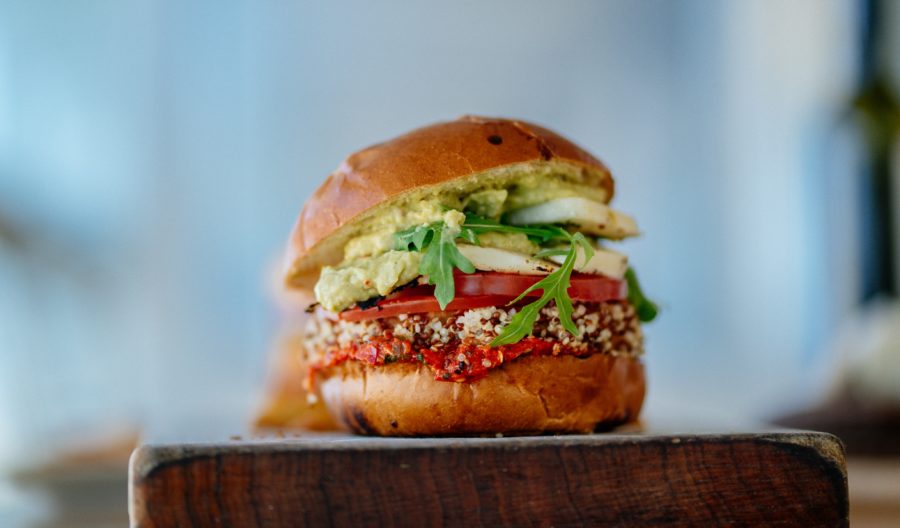
Winter weather challenges chefs to create hearty plant-based meals
I’m talking to the carnivores out there. It’s the middle of winter, and you’ve been eating way too much red meat.
Of course you have. The cold makes us all crave the full, unbeatable umami flavor of a real burger, but chefs have found ways to achieve satisfying alternatives.
The trend is to keep the ingredients fresh natural, bypassing tofu and fillers like breadcrumbs.
Non-beef burgers have come a long way in the past few years, and more restaurants are offering them. Some attempt to imitate the taste of beef. But most don’t, which is wise. A good veggie burger can be as full-flavored as a beef burger without trying to fool a person’s palate.
B.Good, a Boston-based farm-to-table chain with restaurants in Greenwich and Fairfield, does a good job of making eggplants beefy for quality non-beef burgers. Which is a good thing because they serve meat-free meatballs, made from eggplant, either as a side or with zucchini spaghetti.
Eggplant delivers the flavor profile of beef, and even more so at B.Good, where a mix of garlic and oregano brings even more depth to the dish.
Linh Aven, B.Good’s executive chef, has a background as a research scientist, experience that she says serves her well in the kitchen.
“I’ll experiment and experiment for hours,” she says.
Although not a vegetarian, Aven likes the notion that natural foods should be favored over “imitation meat.”
“I’d rather have mushroom or eggplant,” she says.
On another day, we visited a restaurant with a name so similar, we sometimes got tripped up. (It was even more confusing when the short-lived bfresh grocery store was its neighbor.)
Plan B Burger Bar, a small Connecticut-owned chain with restaurants in Stamford, Fairfield and Milford among other places, has two meat-free beef options on its extensive menu. One tries to be a hamburger, the other doesn’t.
It’s the Impossible Burger that tries to fool you. This lab-produced non-beef burger patty made headlines when it was released to the public, mainly because it’s plant-based, and yet seems to “bleed” in its raw state.
The Impossible Burger is like a well-done hamburger patty. It’s best accompanied with more savory condiments such as cheddar cheese, pickles and spicy mustard.
Dan Anderheggen, general manager of the Fairfield branch, confided that his wife is a vegan while he’s a meat lover, but the Impossible Burger is one meal they can share. They also sell “very well,” he adds, because they are hard to find.
The veggie burger sells better, but not buy a large margin.
“Some people that don’t like to eat to eat meat don’t even want to feel like they’re eating meat, and when you eat the Impossible Burger, it’s feels like meat,” says Anderheggen.
Their Organic Veggie Burger, a pattie formed with beans, quinoa and vegetables, is served with the most traditional of fixings: American cheese, lettuce, tomato and onion.
The patties are made in-house, and naturally taste fresher than a frozen patty. They also fall apart a little while handled, but who cares? It was delicious and satisfying. Not beefy at all, but full-flavored. Just the right amount of salt, and even a little sweet.
It struck me after lunch that although I was having a vegetarian lunch at a burger restaurant, I didn’t leave feeling deprived.
Next, we traveled farther down the road and stopped at a Whole Foods to see the veggie burger options in the freezer case.
Years ago, we ate frozen veggie burgers regularly, but quit when we noticed the salt content on the label.
One interesting entry to market is the Dr. Praeger’s brand, which has a lot less salt than some competitors. Its kale-and-quinoa burger, which has “nine other vegetables packed into this powerhouse patty,” is my favorite.
After 12 minutes in a 450-degree oven, the little green-ish patty gave off the aroma of a kale soup that had simmered for hours. I dressed it on a bun with similar toppings to Plan B’s, and found a very rich flavor. Not bright like the fresh burger, but more complex.
Praeger’s has lots of veggie burgers, including one made with mushroom rissoto, another with heirloom beans and one with a “California” blend of carrots, zucchini and red pepper. For extra protein, top it with a fried egg.
The fourth option is to make them at home, from scratch.
America’s Test Kitchen, my go-to for sharpening my cooking skills, has published a veggie burger recipe with one unusual ingredient: carrot baby food from a jar, which acts as a binder and lends a subtle sweetness to the mix.
They also combined pinto beans with beets for the earthiness, walnuts for the richness and bulgur for the chewiness.
Pinto Bean-Beet non-beef Burgers
Servings: 8 | Start to finish: 1 hour
Ingredients:
- Salt and pepper
- 2/3 cup medium-grind bulgur, rinsed
- 1 large beet (9 ounces), trimmed, peeled, and shredded
- 3/4 cup walnuts
- 1/2 cup fresh basil leaves
- 2 garlic cloves, minced
- 1 (15-ounce) can pinto beans, rinsed
- 1 (4-ounce) jar carrot baby food
- 2 tablespoons water
- 1 tablespoon whole-grain mustard
- 1 1/2 cups 100 percent whole-wheat panko bread crumbs
- 6 tablespoons expeller-pressed canola oil, plus extra as needed
Directions:
Bring 1 1/2 cups water and 1/2 teaspoon salt to boil in small saucepan. Off heat, stir in bulgur, cover, and let stand until tender, 15 to 20 minutes. Drain bulgur, spread onto rimmed baking sheet, and let cool slightly.
Meanwhile, pulse beet, walnuts, basil, and garlic in food processor until finely chopped, about 12 pulses, scraping down sides of bowl as needed. Add beans, carrot baby food, water, mustard, 1 1/2 teaspoons salt, and 1/2 teaspoon pepper and pulse until well combined, about 8 pulses. Transfer mixture to large bowl and stir in panko and cooled bulgur.
Adjust oven rack to middle position and heat oven to 200 F. Divide mixture into 8 equal portions and pack into 3 1/2-inch-wide patties.
Heat 3 tablespoons oil in 12-inch nonstick skillet over medium-high heat until shimmering. Gently lay 4 patties in skillet and cook until crisp and well browned on first side, about 4 minutes. Gently flip patties and cook until crisp and well browned on second side, about 4 minutes, adding extra oil if skillet looks dry.
Transfer burgers to wire rack set in rimmed baking sheet and place in oven to keep warm. Wipe out skillet with paper towels and repeat with remaining 3 tablespoons oil and remaining patties. Serve.
The non-beef burger recipe was provided by America’s Test Kitchen to the Associated Press.
Click here to view original web page at Winter weather challenges chefs to create hearty plant-based meals

